At present, chemotherapy is the treatment of choice for patients with malignancy, as it aims to repress growth and prevent cancer spreading toward other organs, and to destroy cancer cells.1-2 Chemotherapy treatment is given over a period of time with continuity of care. This inevitably affects the patients’ quality of life particularly in patients whom experience adverse effects of chemotherapy during treatment. As a result, the patients are frequently worried, anxious, depressed and in despair.3-4 Therefore, any treatments that can routinely lead to adverse effects/reactions need to be administered with scrupulous care. The ability to perform self-care management is essential and is an integral part of the recovery process. If the patients are able to live an effective and fulfilling life, they will feel worthy and feel accepted in society. However, the fact is that patients have to go to hospital regularly for chemotherapy, having to confront the usual side effects such as nausea, vomiting, oral/alimentary ulcer, buccal mucositis, loss of appetite, change in dietary behavior, weight loss, abnormality of bone-morrow system, bleeding tendency, fever, prone to get infection easily, immunocompromised, constipation, diarrhea, loss of body fluid and mineral balance, hair loss and skin color change, and fragile health etc.5 These unfavorable symptoms definitely have an impact on mind and body adaptation as well as patients’ social responsibilities. Therefore, if patients are able to adapt and to manage these symptoms by themselves, they could gain a better quality of life during treatment with chemotherapy.
In addition, the theory of Dodd6 and Chou FY, et al.7 demonstrated the advantages of educating patients regarding chemotherapy’s side effects and symptom management strategies that had a great impact on improving patient’s quality of life.
This was a multi-center, prospective study. Patients who fulfilled inclusion criteria were enrolled in the study as follows: 1) patients aged 18 years or above with solid cancer who received the first chemotherapy and were admitted to either Wattananosoth Hospital, Samitivej Sukhumvit Hospital, Phyathai2 Hospital, Samitivej Sriracha Hospital, or Chonburi Hospital between August 23rd, 2011 and October 1st, 2013, 2) patients who were fully conscious, 3) patients with understandable verbal communication, 4) patients who are literate in either Thai or English, and 5) patients who gave informed consent. Patients with solid cancer who required adjunctive radiation therapy were excluded. The study was approved by the ethical committee of each participating institution of study. Details of the side effects of chemotherapy and symptom self-management were imparted by a nurse.
Data collecting included the following
Demographic data e.g. sex, age, race, marital status, level of education, method of treatment before receiving chemotherapy, disease development, patient’s condition and likelihood of future complications, having a care- giver, basic medication and background information was gathered. Educational levels were categorized as primary school or lower, secondary school, high school/vocational, and university or higher.
Assessment of the level of side effect severity from chemotherapy used the therapy-related symptom checklist (TRSC) form comprising 25-item symptom checklists which classified problems and the level of problem severity into five levels: level 0 = no symptom, 1 = mild, 2 = moderate, 3 = severe, 4 = very severe.
Assessment of symptom management used the self- care method (SCM) comprising identifiable symptoms, self care method and symptom alleviation.8 Five levels of symptoms were classified: 0 = no symptom, 1 = mild, 2 = moderate, 3 = severe, 4 = very severe. Symptom manage- ment strategies were categorized into 1) by changing nutrition and lifestyle choices, 2) by adapting mental and physical behavior, 3) by biological therapy, 4) by herb therapy, 5) by using suggested medication, 6) by doing nothing and hoping circumstances will get better, and 7) by engaging in general activities.
TRSC and SCM were measured by the patients them- selves on day 1 and day 3 after receiving chemotherapy and on the last day of each cycle until the first three cycles of treatment were completed.
Statistics analysis
Descriptive data were presented as absolute numbers, percentages for demographic parameters. Data from TRSC and SCM of each cycle were collected in OMERET program and Cronbach alpha at value of 0.70 was applied for accuracy of measurement.8 One-way analysis of variance (one-way ANOVA) was used. Multivariate analysis using logistic regression analysis was performed to identify the independent factors that influenced patients in applying symptom management strategies during chemotherapy treatment. All statistical analyses were performed using SPSS for Windows, version 10.0 (Statistical Package for Social Science).
A total of 149 patients who met the inclusion criteria were enrolled. There were 121 female (81.2%) and 28 male (18.80%) with an average age of 52.48 years. The educational level of the majority of patients who took part was university-level or higher (45.65%). Diagnoses of solid cancer consisted of breast cancer (57.72%), lung cancer (12.08%), gynecologic cancer (11.41%), colorectal cancer (11.41%), head and neck cancer (3.36%), gastric cancer (2.01%), and others (2.01%) respectively. Staging of cancer showed stage 1 (4.70%), stage 2 (46.98%), stage 3 (30.87%), stage 4 (17.45%). Most patients (94.63%) had a caregiver. Out of all enrolled patients, 73.15% were able to access knowledge about the disease (Table 1). There were 25 adverse symptoms that frequently developed on day 1 of receiving chemotherapy in each cycle such as hair loss (81.21%), taste change (79.19%), skin change (75.17%), loss of appetite (74.50%), and difficulty sleeping (73.15%), shown in Table 2. The level of side effect severity, measured on day 1, day 3 after receiving chemotherapy and on the last day of each cycle until the first three cycles of treatment were completed, were averaged and are shown in Figure 1. Based on the patients’ perceptions, each side effect was ranged in the mild degree except hair loss that was graded in moderate severity. There were no severe or very severe symptoms reported.
Table 1: Patient’s characteristics (n =149).
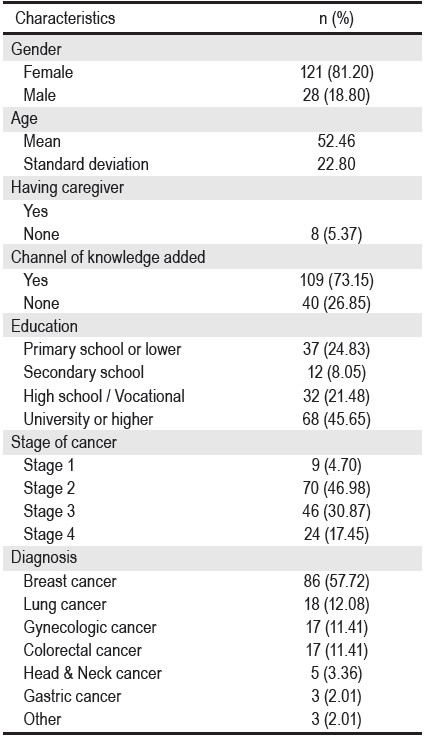
Table 2: The occurrence of side effects on day 1 after receiving chemotherapy in each cycle.
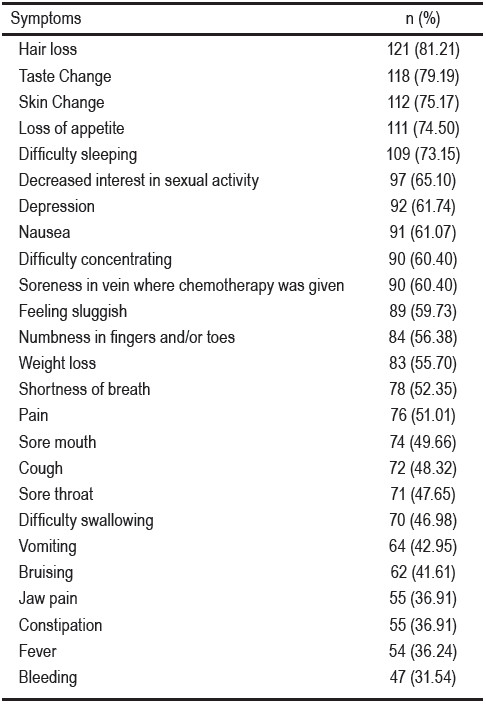
Figure 1: Average of level of severity of chemotherapy’s side effects, measured on day 1, day 3 after receiving chemotherapy and on the last day of receiving chemotherapy in each cycle until the first three cycles of treatment was completed. Level: 0 = no symptoms, 1 = mild, 2 = moderate, 3 = severe, 4 = very severe
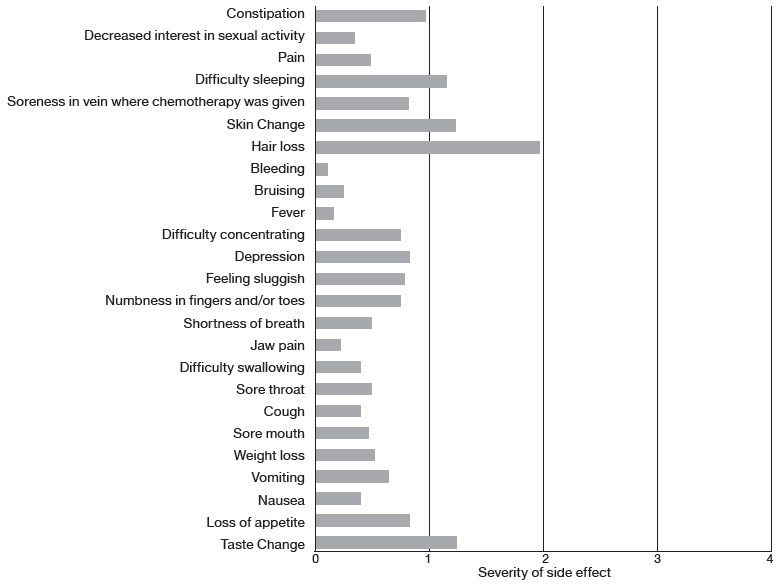
![]() Table 3: The percentage of patients using symptom management strategies during chemotherapy treatment.
Table 3: The percentage of patients using symptom management strategies during chemotherapy treatment.
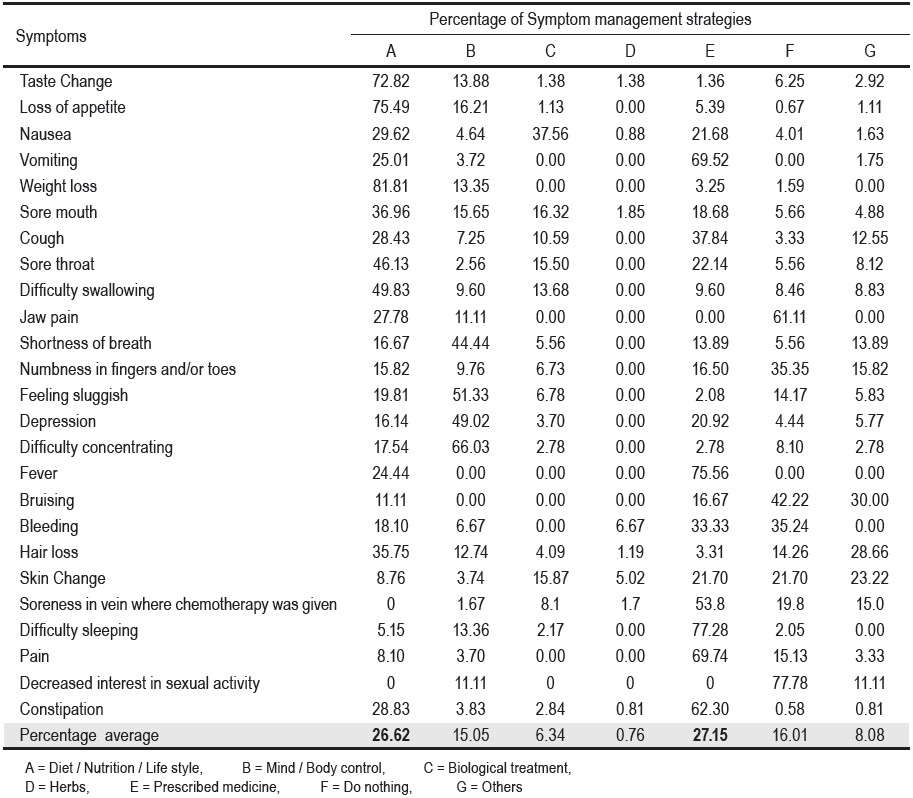
Table 4: General individual factors that impacted on patients who applied symptom management strategies during chemotherapy treatment.
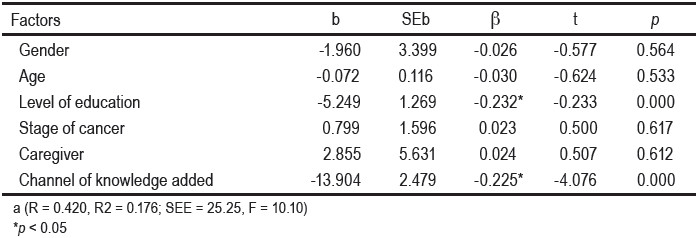
Table 3 shows the symptom management strategy applied by 149 enrolled patients during the first three cycles of treatment: using suggested medication (27.15%), changing nutrition and lifestyle choices (26.62%) (e.g. refraining from eating meat), doing nothing and hoping circumstances will get better (16.01%), adapting mental and physical behavior such as practicing meditation and praying at temple (15.05%), engaging in general activitiessuch as craftsmanship and reading books (8.08%), using biological therapy such as massage with or without hot press, sipping water, and exercise (6.34%), using herb therapy (0.76%). General individual factors that influenced patient in applying symptom management strategies during chemotherapy treatment included: level of educa- tion and having access to data resources about side effect management (Table 4).
According to the theory of Dodd M, et al6 on the apparent advantages of symptom management strategy during chemotherapy treatment in patients with solid cancer, we provided this knowledge and evaluated how our patients have handled symptoms caused by chemo- therapy’s side effects. Results demonstrated significantly low level symptom severity after patients used self-symp- tom management strategies particularly in using suggested medication. This finding was comparable to the study of Piumjariyakul U.8 Our study populations have various ways to take care of themselves. Nurses are encouraged to provide information regarding possible side effects that might occur during treatment with chemotherapy, and are encouraged to advise patients regarding symptom management strategies in order to support their self-care when experiencing unfavorable symptoms caused by chemotherapy. We highlight that patients with solid cancer can benefit from multiple advantages after using symptom management strategies as this can result in optimizing their quality of life by being able to take care of them- selves and to better manage the side effects of treatment.
Side effects of chemotherapy commonly develop during treatment of solid cancer. Educating and providing patients the information regarding symptoms linked to chemotherapy as well as self-care management when experiencing these symptoms is crucial. A symptom management strategy is not only there to ameliorate a patient’s affliction but also to optimize their quality of life during the period of chemotherapy course.
We cordially thank Dr. Ubolrat Piumjariyakul and Professor Phoebe D Williams who allowed us to use software for evaluating symptom management of patients with solid cancer who receive first chemotherapy by using SCM and to measure the level of side effects severity from chemotherapy by using TRSC. We are deeply grateful to the Bangkok Health Research Center and our research consultant, for their assistance in data analysis.